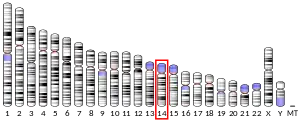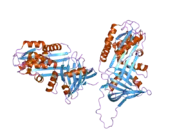Protein C inhibitor
Protein C inhibitor (PCI, SERPINA5) is a serine protease inhibitor (serpin) that limits the activity of protein C (an anticoagulant).
An N-terminal fragment of PCI is a possible serum biomarker for prostate cancer.[5]
Protein C inhibitor is activated by heparin against thrombin.[6]
Protein C inhibitor (PCI) is serine protease inhibitor of serpin type that is found in most tissues and fluids, including blood plasma, seminal plasma and urine of human.[7] It is a 52kD glycoprotein and belongs to serine protease inhibitor ( Serpin) super family of protein.[7] In the beginning protein C Inhibitor (PCI) was identified as an inhibitor of activated protein C (APC), it is currently clear that this inhibitor has an expansive specificity, inhibiting several blood coagulation enzymes counting thrombin and factor Xa.[8][9]
Isolation
In the beginning, protein C inhibitor(PCI) was originally identified in human plasma by Griffin and Marlar[10] and first isolation was performed by Suzuki et al.[11] Protein C inhibitor (PCI) can be isolated from human plasma using an ordinary chromatographic procedure consisting of barium citrate adsorption, polyethylene glycol fractionation, DEAE-Sepharose CL-6B treatment, ammonium sulfate fractionation, dextran sulfate-agarose chromatography, gel filtration on ACA-44, and DEAE-Sephacel chromatography.[11][12]
Structure
The structure (primary structure) of protein C inhibitor was deduced from its cDNA nucleotide sequence. The human Protein C inhibitor have 19 amino acid signal peptide.[13]
Gene organization
The study of genomic DNA by restriction mapping, polymerase chain reaction analysis and DNA sequencing showed the gene being 11.5 kilobases in length, consisting of five exons separated by four introns.[12] The genetic code of protein C inhibitor is similar to alpha 1-antitrypsin and alpha 1-antichymotrypsin.[12]
Metabolism
The in vivo half time degradation of protein C inhibitor in plasma is found to be 23 hours, whereas the half time degradation of protein C inhibitor and protein C complex is 20 minutes.[14]
Binding with heparin
Protein C inhibitors have ability to inhibit protein C, thrombin and other enzymes that are stimulated by heparin. The heparin binding site of protein C inhibitor is from 264-283 region.[9] Heparin enhances the rate of inhibition leading to the conformational change in the structure of Protein C and other proteases. The binding site of heparin is different for protein C inhibitor and other proteases[14] Heparin regulates the protein C inhibitor (PCI) activity and furthermore its specificity in those system where there is presence of two or more target proteases.[15]
Clinical significance
As an antimicrobial agent
Protein C inhibitor interacts with lipid membrane subsequently leading to permeabilization of bacterial pathogen exerting the antimicrobial activity. Protein C inhibitor a potent antimicrobial agent that have ability to destroy the bacterial cell wall, causing death of the bacteria.[16]
Reproduction
Protein C inhibitor significantly reduces fertilization by inhibiting both the binding and penetration of zona free hamster oocytes by human sperm. This effect of PCI is dose dependent as 0.04MicroM PCI inhibited 50% binding and penetration ability.[17]
Inhibition of tumor growth
PCI communicated by malignant cells smothers tumor invasion by hindering urokinase-sort plasminogen activator, and restrains tumor development and metastasis which is independent of its protease inhibitory activity.[18]
Deficiency
Deficiency of protein C inhibitor in the human body may cause male infertility. Protein C inhibitor has a role in reproduction as it has ability to inhibit the sperm protease acrosin.[19] Large amounts of protein C inhibitor circulate in the male reproductive organ as a plasma protein.[19] Either deficiency or the presence of inactive protein C inhibitor can lead to male caused infertility.[20]
Interactions
Protein C inhibitor has often been shown to interact with prostate specific antigen,[21][22] protein C[23][24] and PLAU.[23][25]
See also
References
- GRCh38: Ensembl release 89: ENSG00000188488 - Ensembl, May 2017
- GRCm38: Ensembl release 89: ENSMUSG00000041550 - Ensembl, May 2017
- "Human PubMed Reference:". National Center for Biotechnology Information, U.S. National Library of Medicine.
- "Mouse PubMed Reference:". National Center for Biotechnology Information, U.S. National Library of Medicine.
- Rosenzweig, C. Nicole; Zhang, Zhen; Sun, Xiaer; Sokoll, Lori J.; Osborne, Katherine; Partin, Alan W.; Chan, Daniel W. (March 2009). "Predicting Prostate Cancer Biochemical Recurrence Using a Panel of Serum Proteomic Biomarkers". The Journal of Urology. 181: 1407–14. doi:10.1016/j.juro.2008.10.142. PMC 4130150. PMID 19157448.
- Huntington JA (June 2013). "Thrombin inhibition by the serpins". Journal of Thrombosis and Haemostasis. 11 Suppl 1: 254–64. doi:10.1111/jth.12252. PMID 23809129.
- Laurell M, Christensson A, Abrahamsson PA, Stenflo J, Lilja H (April 1992). "Protein C inhibitor in human body fluids. Seminal plasma is rich in inhibitor antigen deriving from cells throughout the male reproductive system". The Journal of Clinical Investigation. 89 (4): 1094–101. doi:10.1172/JCI115689. PMC 442965. PMID 1372913.
- Boulaftali Y, Adam F, Venisse L, Ollivier V, Richard B, Taieb S, Monard D, Favier R, Alessi MC, Bryckaert M, Arocas V, Jandrot-Perrus M, Bouton MC (January 2010). "Anticoagulant and antithrombotic properties of platelet protease nexin-1". Blood. 115 (1): 97–106. doi:10.1182/blood-2009-04-217240. PMID 19855083.
- Pratt CW, Church FC (May 1992). "Heparin binding to protein C inhibitor" (PDF). The Journal of Biological Chemistry. 267 (13): 8789–94. PMID 1315738.
- Marlar RA, Griffin JH (1980). "Deficiency of protein C inhibitor in combined factor V/VIII deficiency disease". The Journal of Clinical Investigation. 66 (5): 1186–9. doi:10.1172/JCI109952. PMC 371561. PMID 6253526.
- Suzuki K, Nishioka J, Hashimoto S (1983). "Protein C inhibitor. Purification from human plasma and characterization". The Journal of Biological Chemistry. 258 (1): 163–8. PMID 6294098.
- Meijers JC, Chung DW (August 1991). "Organization of the gene coding for human protein C inhibitor (plasminogen activator inhibitor-3). Assignment of the gene to chromosome 14". The Journal of Biological Chemistry. 266 (23): 15028–34. PMID 1714450.
- Suzuki K, Deyashiki Y, Nishioka J, Kurachi K, Akira M, Yamamoto S, Hashimoto S (January 1987). "Characterization of a cDNA for human protein C inhibitor. A new member of the plasma serine protease inhibitor superfamily". The Journal of Biological Chemistry. 262 (2): 611–6. PMID 3027058.
- Suzuki K (1 March 2000). "Protein C inhibitor (PAI-3): structure and multi-function". Fibrinolysis and Proteolysis. 14 (2): 133–145. doi:10.1054/fipr.2000.0063.
- Geiger M, Zechmeister-Machhart M, Uhrin P, Hufnagl P, Ecke S, Priglinger U, Xu J, Zheng X, Binder BR (1996). "Protein C inhibitor (PCI)". Immunopharmacology. 32 (1–3): 53–6. doi:10.1016/0162-3109(96)00013-6. PMID 8796266.
- Malmström E, Mörgelin M, Malmsten M, Johansson L, Norrby-Teglund A, Shannon O, Schmidtchen A, Meijers JC, Herwald H (December 2009). "Protein C inhibitor--a novel antimicrobial agent". PLoS Pathogens. 5 (12): e1000698. doi:10.1371/journal.ppat.1000698. PMC 2788422. PMID 20019810.
- España F, Navarro S, Medina P, Zorio E, Estellés A (February 2007). "The role of protein C inhibitor in human reproduction". Seminars in Thrombosis and Hemostasis. 33 (1): 41–5. doi:10.1055/s-2006-958460. PMID 17253188.
- Akita N, Ma N, Okamoto T, Asanuma K, Yoshida K, Nishioka J, Shimaoka M, Suzuki K, Hayashi T (June 2015). "Host protein C inhibitor inhibits tumor growth, but promotes tumor metastasis, which is closely correlated with hypercoagulability". Thrombosis Research. 135 (6): 1203–8. doi:10.1016/j.thromres.2015.03.026. PMID 25887633.
- Uhrin P, Dewerchin M, Hilpert M, Chrenek P, Schöfer C, Zechmeister-Machhart M, Krönke G, Vales A, Carmeliet P, Binder BR, Geiger M (December 2000). "Disruption of the protein C inhibitor gene results in impaired spermatogenesis and male infertility". The Journal of Clinical Investigation. 106 (12): 1531–9. doi:10.1172/JCI10768. PMC 381472. PMID 11120760.
- He S, Lin YL, Liu YX (June 1999). "Functionally inactive protein C inhibitor in seminal plasma may be associated with infertility". Molecular Human Reproduction. 5 (6): 513–9. doi:10.1093/molehr/5.6.513. PMID 10340997.
- Christensson A, Lilja H (February 1994). "Complex formation between protein C inhibitor and prostate-specific antigen in vitro and in human semen". European Journal of Biochemistry / FEBS. 220 (1): 45–53. doi:10.1111/j.1432-1033.1994.tb18597.x. PMID 7509746.
- Kise H, Nishioka J, Kawamura J, Suzuki K (May 1996). "Characterization of semenogelin II and its molecular interaction with prostate-specific antigen and protein C inhibitor". European Journal of Biochemistry / FEBS. 238 (1): 88–96. doi:10.1111/j.1432-1033.1996.0088q.x. PMID 8665956.
- España F, Berrettini M, Griffin JH (August 1989). "Purification and characterization of plasma protein C inhibitor". Thrombosis Research. 55 (3): 369–84. doi:10.1016/0049-3848(89)90069-8. PMID 2551064.
- Strandberg K, Kjellberg M, Erb EM, Persson U, Mosher DF, Villoutreix BO, Stenflo J (December 2000). "Activated protein C-protein C inhibitor complex formation: characterization of a neoepitope provides evidence for extensive insertion of the reactive center loop". Biochemistry. 39 (51): 15713–20. doi:10.1021/bi001640h. PMID 11123896.
- Geiger M, Huber K, Wojta J, Stingl L, Espana F, Griffin JH, Binder BR (August 1989). "Complex formation between urokinase and plasma protein C inhibitor in vitro and in vivo". Blood. 74 (2): 722–8. PMID 2752144.
Further reading
- Suzuki K, Hayashi T (2000). "cis-elements required for expression of human protein C inhibitor gene in HepG2 cells and its androgen-dependent expression in rat reproductive organs". Seminars in Thrombosis and Hemostasis. 26 (1): 75–83. doi:10.1055/s-2000-9807. PMID 10805286.
- Yasuda T, Nadano D, Iida R, Tanaka Y, Nakanaga M, Kishi K (May 1992). "Discovery of a genetic polymorphism of human plasma protein C inhibitor (PCI): genetic survey utilizing isoelectric focusing followed by immunoblotting, immunological and biochemical characterization". Human Genetics. 89 (3): 265–9. doi:10.1007/BF00220537. PMID 1318261.
- Kuhn LA, Griffin JH, Fisher CL, Greengard JS, Bouma BN, España F, Tainer JA (November 1990). "Elucidating the structural chemistry of glycosaminoglycan recognition by protein C inhibitor". Proceedings of the National Academy of Sciences of the United States of America. 87 (21): 8506–10. doi:10.1073/pnas.87.21.8506. PMC 54985. PMID 2172989.
- Meijers JC, Chung DW (July 1990). "Evidence for a glycine residue at position 316 in human protein C inhibitor". Thrombosis Research. 59 (2): 389–93. doi:10.1016/0049-3848(90)90142-Y. PMID 2173165.
- Laurell M, Stenflo J (November 1989). "Protein C inhibitor from human plasma: characterization of native and cleaved inhibitor and demonstration of inhibitor complexes with plasma kallikrein". Thrombosis and Haemostasis. 62 (3): 885–91. doi:10.1055/s-0038-1651022. PMID 2556811.
- Geiger M, Huber K, Wojta J, Stingl L, Espana F, Griffin JH, Binder BR (August 1989). "Complex formation between urokinase and plasma protein C inhibitor in vitro and in vivo". Blood. 74 (2): 722–8. PMID 2752144.
- Zheng X, Geiger M, Ecke S, Bielek E, Donner P, Eberspächer U, Schleuning WD, Binder BR (August 1994). "Inhibition of acrosin by protein C inhibitor and localization of protein C inhibitor to spermatozoa". The American Journal of Physiology. 267 (2 Pt 1): C466–72. doi:10.1152/ajpcell.1994.267.2.C466. PMID 7521127.
- Radtke KP, Fernández JA, Greengard JS, Tang WW, Wilson CB, Loskutoff DJ, Scharrer I, Griffin JH (November 1994). "Protein C inhibitor is expressed in tubular cells of human kidney". The Journal of Clinical Investigation. 94 (5): 2117–24. doi:10.1172/JCI117566. PMC 294656. PMID 7525654.
- Hayashi S (December 1993). "Urinary protein C inhibitor binding region in the B beta-chain of human fibrinogen". Blood Coagulation & Fibrinolysis. 4 (6): 921–6. doi:10.1097/00001721-199304060-00009. PMID 8148485.
- Hayashi T, Suzuki K (October 1993). "Gene organization of human protein C inhibitor, a member of SERPIN family proteins encoded in five exons". International Journal of Hematology. 58 (3): 213–24. PMID 8148499.
- Billingsley GD, Walter MA, Hammond GL, Cox DW (February 1993). "Physical mapping of four serpin genes: alpha 1-antitrypsin, alpha 1-antichymotrypsin, corticosteroid-binding globulin, and protein C inhibitor, within a 280-kb region on chromosome I4q32.1". American Journal of Human Genetics. 52 (2): 343–53. PMC 1682208. PMID 8381582.
- Hayashi S, Yamada K (February 1993). "Binding of urinary protein C inhibitor to fibrin(ogen) and its binding mechanism". Blood Coagulation & Fibrinolysis. 4 (1): 153–8. doi:10.1097/00001721-199304010-00027. PMID 8384496.
- Moore A, Penfold LM, Johnson JL, Latchman DS, Moore HD (March 1993). "Human sperm-egg binding is inhibited by peptides corresponding to core region of an acrosomal serine protease inhibitor". Molecular Reproduction and Development. 34 (3): 280–91. doi:10.1002/mrd.1080340308. PMID 8471250.
- Hayashi S, Wakizaka A (July 1995). "Urinary protein C inhibitor binding region in the A alpha-chain of human fibrinogen". Blood Coagulation & Fibrinolysis. 6 (5): 382–7. doi:10.1097/00001721-199507000-00003. PMID 8589203.
External links
- The MEROPS online database for peptidases and their inhibitors: I04.004
- Protein+C+inhibitor at the US National Library of Medicine Medical Subject Headings (MeSH)








